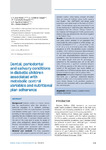
Please use this identifier to cite or link to this item:
http://ricaxcan.uaz.edu.mx/jspui/handle/20.500.11845/853| Title: | Dental, periodontal and salivary conditions in diabetic children associated with metabolic control variables and nutritional plan adherence |
| Authors: | Díaz Rosas, Cristal Yurixie Cárdenas Vargas, Edith Castañeda Delgado, Julio Enrique Aguilera Galaviz, Luis Alejandro Aceves Medina, María del Carmen |
| Issue Date: | 2018 |
| Publisher: | Italian Society of Pediatric Dentistrv |
| Abstract: | Diabetes mellitus is a chronic disease that has manifestations other than alterations in endocrine regulation or in metabolic pathways. Several diseases of the oral cavity have been associated with diabetes mellitus type 1 and 2 in young people according to their evolution. Scarce information exists regarding the role of diabetes and its association with the oral health status in paediatric diabetic patients. The aims of the study were to assess the quality of saliva, saliva acidogenicity, dental caries experience, fluorosis and periodontal status in diabetic patients and to evaluate their relationship with metabolic control variables and nutritional plan adherence. Material and methods The study population consisted of 60 paediatric patients with both types of diabetes mellitus. Saliva testing included stimulated flow, pH (using pH indicator strips), buffer capacity and Snyder’s Test. DMFT/dmft and dental caries experience were determined on the basis of ICDAS II codes. The periodontal status was assessed by PI and GI and fluorosis by FI. Nutritional plan adherence was established from the subscale “Dietary Control” of the Diabetes Self-Management Profile questionnaire. Medical Data was retrieved from the clinical registers in the Diabetic Clinic. Results We describe the main characteristics of the oral cavity related variables of our population that might guide the clinical practice in similar settings; we found a dmft/DMFT of 1.71 ± 1.74 and 0.64 ± 1.03, PI of 1.91 ± 0.75, GI of 0.50 ± 0.56 and a fluorosis prevalence of 61%. We identified several correlated variables, which indicate strong associations between the nutritional habits of the patients and co-occurrence of oral cavity physiopathological alterations. Several correlations were found between acidogenic activity of the saliva (Snyder Test) and the percentage of adherence to the nutritional plan and to the dmft index. Furthermore, a significant correlation between the buffering capacity of the saliva and the glycemic control of the participants was found. Neither an association nor a difference among means was found between treatment regime and the plaque index. Conclusion The results of the present study concluded that there was a significant relationship between diabetes mellitus and an increased prevalence of oral cavity related diseases in the paediatric population. These are also associated with a poor adherence to the nutritional plan. |
| URI: | http://localhost/xmlui/handle/20.500.11845/853 https://doi.org/10.48779/fqjd-y319 |
| ISSN: | 2035-648X |
| Other Identifiers: | info:eu-repo/semantics/publishedVersion |
| Appears in Collections: | *Documentos Académicos*-- UA Odontología |
Files in This Item:
| File | Description | Size | Format | |
|---|---|---|---|---|
| B European Journal of Pediatric Dentistry.pdf | 758,49 kB | Adobe PDF |  View/Open |
This item is licensed under a Creative Commons License
